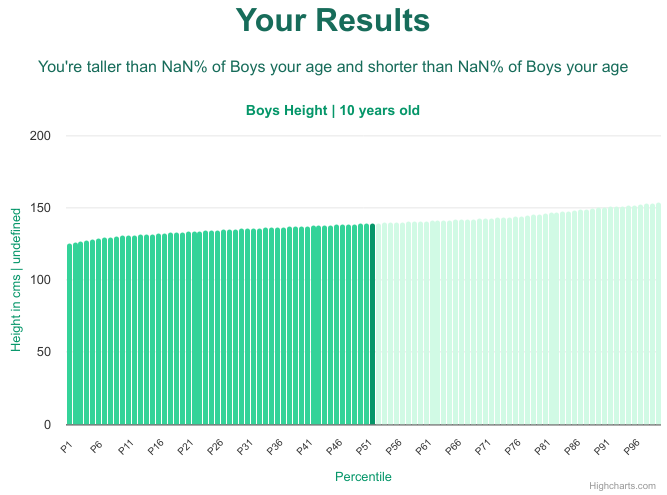Boys Height chart for Children 10 years old

General Summary: 10 years old boys height
In most cases, height measurements for 10 years old boys will be in the range between 126 and 151 cms. The average height for 10 years old boys is 138 cms, according to the CDC and anonymized data from users.
All Results
Enter your height measurements above to see how they compare
So far, we have recorded [0] height measurements for 10-years-old boys on LifeMeasure!
(chart updates daily)
The Average Height of 10-Year-Old Boys: Growth Patterns and Key Influences
Height is an important predictor of a child's overall growth and health. Parents frequently question if their child is developing at a regular rate compared to classmates. While individual growth varies due to genetics, diet, and lifestyle variables, knowing the average height of a 10-year-old boy can help predict typical development. This article discusses the usual height range for 10-year-old boys, variables that influence growth, and when to seek medical attention.
What Is the Average Height for a 10-Year-Old Boy?
Welcome to the world of 10-year-old boys, where growth and development continue to shape their journey. At this stage, boys are entering the double digits and embarking on an exciting period of growth and self-discovery. Let's explore some key aspects of their growth and development:
You can use our Height Calculator to estimate your child's projected height based on growth patterns.
According to the Centers for Disease Control and Prevention (CDC) and the World Health Organization (WHO), the typical height of a 10-year-old boy is 50 to 59 inches (127 cm to 150 cm). This variable compensates for the varying development rates caused by genetics, environment, and diet. It's important to remember that growth rates can vary among individuals, and every child follows their own unique growth trajectory.
Growth Percentiles and Height Distribution
Doctors and healthcare professionals use growth percentiles to compare a child's height to that of other children his or her age. The following is a general breakdown of height percentiles for 10-year-old males:
5th percentile: Approximately 48 inches (122 centimeters)
50th percentile (average height): Around 53 inches (135 centimeters)
95th percentile: Approximately 57 inches (145 centimeters)
These percentiles offer a general indication of how a 10-year-old boy's height compares to his peers. Children who fall below the 5th percentile or rise beyond the 95th percentile may benefit from a medical evaluation to rule out any underlying health issues.
Developmental Milestones for 10-Year-Old Boys
Physical Development:
Boys continue to develop physically even at the age of 10. They develop strength, agility, and coordination, allowing them to participate in a variety of physical activities and sports. Encouraging an active lifestyle, supporting regular exercise, and offering chances for skill development and teamwork may all benefit their physical well-being and overall progress.
Cognitive Development:
During this period, 10-year-old males enhance their cognitive capacities by developing critical thinking skills, logical reasoning, and problem-solving ability. They become more self-sufficient learners, able to explore new topics and delve deeper into their passions. Nurturing their curiosity, giving difficult learning situations, and encouraging kids to ask questions and seek information may all help their cognitive growth.
Social and Emotional Development:
Social and emotional development remains an important component of a 10-year-old boy's maturation. They manage more intricate social interactions, build more intimate bonds, and develop understanding and compassion for others. Encouraging pleasant social connections, teaching effective communication and conflict resolution skills, and cultivating a sense of community and inclusion may all help them feel better emotionally.
Language Development:
Language skills continue to increase at the age of 10 as males improve their communication abilities. They broaden their vocabulary, create more advanced linguistic structures, and convey their thoughts and ideas more clearly. Encourage reading, engage in meaningful discussions, and provide chances for written expression to help them develop their language skills.
When to Seek Medical Advice
Most children grow at their own pace, but certain red flags warrant medical evaluation:
Growth rate significantly below or above the expected percentile range.
Sudden growth plateau or decrease in height percentile.
Signs of puberty before 9 years old or delayed signs after 12 years old.
A history of medical conditions affecting growth (e.g., celiac disease, hormonal imbalances).
A pediatrician can assess growth patterns using bone age X-rays, blood tests, and family history analysis to determine if medical intervention is needed.
Some Tips for Parents and 10-Year-Olds:
Foster open communication and actively listen to one another's thoughts and feelings.
Encourage independence and decision-making skills while providing guidance and support.
Promote a healthy balance between school, extracurricular activities, and leisure time.
Cultivate a love for reading by exploring various genres and discussing favorite books together.
Embrace challenges and view failures as opportunities for growth and learning.
Practice empathy and respect for others, embracing diversity and understanding different perspectives.
Develop good study habits and organizational skills to manage schoolwork effectively.
Engage in family activities that promote bonding, such as outings, game nights, and shared hobbies.
Encourage active participation in community service or volunteering to foster a sense of social responsibility.
Prioritize self-care, including proper nutrition, regular exercise, and adequate rest.
Conclusion
The average height of a 10-year-old boy ranges from 50 to 59 inches (127 cm to 150 cm), depending on heredity, diet, and lifestyle. While individual growth rates differ, a healthy lifestyle promotes optimal development. Parents should use percentile charts to track their child's development trends and seek medical advice if abnormal growth patterns arise.
Children who prioritize good diet, physical exercise, and sleep can reach their full development potential while remaining healthy and active.
See more ages